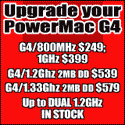|
Written by Perry Longinotti, our 3D gaming Canadian remote mad scientist
Edited and posted 12/31/03 by Rob-ART Morgan, Chief Mad Scientist
Halo Background
Halo is a game that is steeped in much folklore. When it was first shown to the public back in 1999 running on a blue and white G3 it was instantly hailed as a future classic; a game that would become a killer app and whose inherent quality would actually get people to buy hardware in order to play it. Sadly, while the prophecy came true for the most part, the system Halo helped sell was not the Mac, but the Microsoft Xbox. For many in the Mac community, Bungie (Halo's developer) was seen as a sellout that betrayed the community that had supported it.
I, for one, cannot begrudge Bungie for achieving some financial security at the expense of the Mac community. They got bought while Microsoft was in a spending mood and the success of Halo has catapulted them from obscure Mac developer to closely watched tier one mega developer. It was a good business decision that has paid off in both fame and fortune.
Consolation to Mac users everywhere is that after a delay, the Mac version of Halo is finally upon us and that PC users have had to wait almost as long as us.
If you have been keeping up on the topic of user reaction to Halo, both on the Mac and PC platforms, two universal trends will immediately become clear. First, the game experience encompasses a high caliber single player story and a shelf life prolonging online multiplayer mode. Second, very few people possess hardware capable of recreating images comparable to the still shots in magazine and on the box at a decent frame rate.
If you arrived at this article hoping to find some incendiary materials to fuel a flame war on your favorite message board you will be disappointed. This author does not believe in perpetuating platform polemics.
Halo Performance
A lot is being written about Halo performance, but the best source of information is the literature published on the topic by the Mac and PC developers. Each version of Halo includes either a decent online FAQ or Read Me file.
Mac users are treated to a configuration menu when the game loads initially. There are three rendering code paths (from low to high), No Shaders, Vertex Shaders and Vertex & Pixel Shaders. Only the options supported by your video card will appear. If your card supports Vertex & Pixel Shaders, you may also enable 'Detail Objects.' Detail objects are kind-of self explanatory, but some mention of what the benefit is in the Read Me document would be a good idea. Rounding out the rendering options are Full Scene Anti Aliasing, Lens Flare, and Model Detail options. Halo can be played in a window and the launcher includes a handy Time Demo tool.
The PC offers slightly less in the way of easily accessible rendering options, it relies instead on a configuration file that lists pretty much every video card made in the past ten years and associates a rendering code path with them. This approach works well and allows Halo to make the choice for the consumer based on the capability of their hardware. The choices are, fixed function (DX 7 era video cards), Pixel Shaders 1.1 (DirectX 8.0), Pixel Shaders 1.4 (DirectX 8.0), and Pixel Shaders 2.0 (DirectX 9.0). You can learn more about what the different code paths offer by reading the official FAQ here. Code paths may be 'forced' through command line arguments. This is also the way to activate the PC version's Time Demo feature. Relying on the command line for advanced configuration may be less user-friendly than the Mac approach, but it is nothing the average PC user can't endure.
The in-game setup options are identical.
When testing the game out on both platforms, we did everything we could to keep settings the same across the board, but the extra configuration options on the Mac version meant that exact matches were impossible.
Getting the Most From Halo
There are lots of ways to tweak the performance of Mac Halo to get decent experience. These can be distilled into two approaches, one for the single player game and the other for multiplayer. The integrated Time Demo function will aid us in determining the best settings for Halo on our machines.
The single player experience is greatly enhanced by all of the pretty visuals Halo is capable of. I recommend that you select the highest possible rendering code path for your hardware. Start with the lowest resolution possible (640*480) and low detail settings. From here, increase the launcher and in-game video settings in gradual steps running a Time Demo between each change. Try dialing up the detail settings as high as possible while being able to achieve a time demo of at least 35 frames per second (FPS) average. This will require some trial and error. For my MDD PowerMac 1.25 I found the following settings worked best:
No Shaders
FSAA - Off
Lens Flare Low
Model Detail Medium
###Video Options###
Resolution= 800 x 600
Refresh rate= 0 Hz
Framerate throttle= No Vsync
Specular= No
Shadows= No
Decals= No
Particles= Off
Texture Quality= Medium
This setup gets me 37.5 fps. This should provide a relatively smooth experience with some slow down in the most intense firefights. Just slightly over 30% of the time, the time demo dipped below the magic 24 fps that we perceive as fluid motion.
This may seem low like settings, but a Windows powered machine with a 1.25Ghz CPU and RADEON 9000 will achieve similar results.
For multiplayer, if you find that the single player settings you use result in slow down at in-opportune times, try lowering the visual settings to the bare minimum. If this works, the next step would be to increase resolution a notch or two and test if game play is still smooth. A higher resolution is generally regarded as more important in multiplayer than eye candy.
Conclusion
Gamers with average Macs, much like their Windows counterparts, are going to have to make some compromises in order to play this game. While those people who are fortunate enough to have a high-end machine are going to experience Halo in all its glory.
Many a forum thread has been dedicated to the whys and who-done-its of Halo performance, but the simple truth is that this is the way of things. Games come out that make us buy new hardware. Simple.
The Mac developers in particular did an exceptional job. Porting a showcase DirectX 9 game to OpenGL could not have been easy.
In a few ways, the Mac version actually beats the PC version. The Mac version offers Anti Aliasing and greater control over rendering options. The extra settings are useful in getting Halo running comfortably on an average iMac or PowerMac. On the high end, our testing shows that there is surprisingly little difference between Apple's latest dual G5 and Wintel's fastest.
GO BACK TO PAGE ONE HALO GRAPHS... or...
RETURN to Main BARE FEATS Index Page.
Has Bare Feats helped you?
How about helping Bare Feats?
|
![]()








